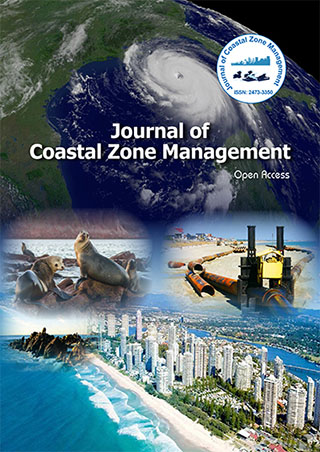Indexed In
- SafetyLit
- RefSeek
- Hamdard University
- EBSCO A-Z
- OCLC- WorldCat
- Publons
Useful Links
Share This Page
Journal Flyer

Open Access Journals
- Agri and Aquaculture
- Biochemistry
- Bioinformatics & Systems Biology
- Business & Management
- Chemistry
- Clinical Sciences
- Engineering
- Food & Nutrition
- General Science
- Genetics & Molecular Biology
- Immunology & Microbiology
- Medical Sciences
- Neuroscience & Psychology
- Nursing & Health Care
- Pharmaceutical Sciences
Perspective - (2022) Volume 25, Issue 9
Evaluation of Coastal Erosion Caused by Port Brackish Waters
Yasir Hamid*Received: 05-Sep-2022, Manuscript No. JCZM-22-18195; Editor assigned: 07-Sep-2022, Pre QC No. JCZM-22-18195 (PQ); Reviewed: 22-Sep-2022, QC No. JCZM-22-18195; Revised: 30-Sep-2022, Manuscript No. JCZM-22-18195 (R); Published: 07-Oct-2022, DOI: 10.35248/2473-3350.22.25.524
Description
Natural environments that produce brackish water have a salinity that is higher than that of freshwater but lower than that of seawater. It can happen in brackish fossil aquifers or as a result of the mixing of fresh water with salt water, as in estuaries.
Without changing the structure in its entire setting, it is impossible to analyses how the port breakwaters affect coastal erosion. Additionally, the relationship between "vulnerability" and "risk" must be considered while approaching it. The risk is mostly associated with hydraulics, which is the erosive power, and morphology to a lesser extent. It is known that morph dynamics and lithology are related to the vulnerability. Given the wide range of characteristics and the fact that a port breakwater is almost always a prototype, it is very challenging to draw generalizations that hold true in all circumstances. However, if we limit ourselves to a few specific standard scenarios, we may understand the main consequences that the port breakwaters have on the environment. Three different port types are examined:
a) Isolated environments,
b) River mouths in the sea and
c) Mouths of sizable estuaries.
Ports in an isolated environment
Ports in remote areas have tidal seas and very little to no river contribution in the basins. The incidental waves in this instance diffract on the pier head and the breakwater is positioned perpendicular to their direction of propagation. This phenomenon alters the wave directions of assault at the coast, upsetting a preexisting equilibrium and causing erosion of varying importance depending on the lithological makeup of the shore. If the coast is sandy, erosion is significant but limited in scope if there is no coastal current. While erosion processes can be controlled, they are not the same as those associated with pollution brought on by harbor traffic because basins are relatively isolated constructions with little to no contact with the open sea.
Tides and coastal currents can affect ports that are situated at a river's mouth in a body of water. In this situation, the river flow shouldn't be hampered by the breakwater that serves as protection against incidental waves. They are therefore constructed to extend this one's bed. Thus, the port's entrance comprises of two parallel breakwaters that are often constructed perpendicular to the coast. The stability of the coast in tide- and coastal-current-affected seas results from a delicate balance between erosion caused by the movement of sediments downstream and fattening caused by the contribution of sediments from upstream. Building breakwaters perpendicular to the coast prevents the passage of coastal debris and breaks this balance.
Due to the breakwater's blockage of the coastal current, the sediments carried downstream by the coastal current are not made up for by a contribution upstream, which leads to higher erosion. As a result, the coast is severely battered by waves downstream of the work due to refraction around it.
Here, protecting the estuary's mudflat area is more crucial than ensuring the stability of the coastal feature. In fact, the upper portion of an estuary typically represents a wetland of significant ecological importance in the absence of human interference.
By contribution of the river sediments, these wetlands or mudflat areas migrate permanently towards the downstream. In contrast, the ports construct breakwaters to defend themselves from the silting up of their basins. These breakwaters actually canalize river water, limiting sedimentation and, consequently, any migration of the mudflat areas towards the downstream, while they continue to be filled upstream. This leads to the wetlands' extinction, despite the fact that they are crucial from an ecological standpoint. The many stakeholders in the administration of coastal zones have just recently become aware of this issue. To protect these wetlands without hindering economic development, compensatory solutions were developed, for instance, at the time of the enlargement of the port of Le Havre at the mouth of the Seine.
Citation: Hamid Y (2022) Evaluation of Coastal Erosion Caused by Port Brackish Waters. J Coast Zone Manag. 25:524.
Copyright: © 2022 Hamid Y. This is an open-access article distributed under the terms of the Creative Commons Attribution License, which permits unrestricted use, distribution, and reproduction in any medium, provided the original author and source are credited.
